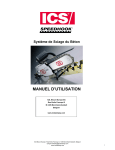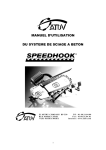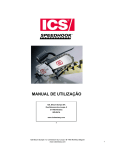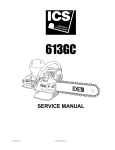Download Schematic - Jon-Don
Transcript
Dual Component Polymer Pump Operating Manual Toll Free 1-877-817-6687 3702 West Central Avenue Santa Ana, CA 92704 11 High Street Suffield, CT 06078 www.ussaws.com 8004B East Broadway Avenue Tampa, FL 33619 Introduction This manual outlines the maintenance and operation of the Dual Component Polymer Pump. This is a professional tool and is intended for use by trained and experienced operators. To get maximum benefit from your tool and to ensure maximum safety, be sure to read this manual thoroughly. You should also periodically review safety instructions. Specifications Part Number Capacity Electrical Requirements Motor Dimensions Weight SX20000 2 - 5 Gallon Tanks 120 V 1/2 HP 220 lbs Table of Contents Symbols & Labels3 Safety4 Set - Up and Operation5 Troubleshooting9 Disclosure11 Parts12 Dual Component Polymer Pump 2 Symbols & Labels The following symbols and definitions are found throughout this manual and are designed to make you 633GC aware of potential hazards or SYMBOLS & LABELS TITLE / 633F4 OPERATOR’S MANUAL unsafe practices. THE FOLLOWING SYMBOLS & DEFINITIONS ARE FOUND THROUGHOUT THIS MANUAL AND ARE DESIGNED TO MAKE YOU AWARE OF POTENTIAL HAZARDS OR UNSAFE PRACTICES. WARNING A potentially hazardous situation exists which, if not avoided, could result in death or serious injury. CAUTION A potentially hazardous situation exists which, if not avoided, may result in minor or moderate injury or property damage. IMPORTANT A potential situation exists which, if not avoided, may result in product or property damage. THE FOLLOWING SYMBOLS & LABELS MAY BE FOUND IN THIS MANUAL OR ON THE SAW Read the operator’s manual carefully and understand the contents before you use this equipment. Always use: • Protective helmet • Ear protection • Protective glasses or full face protection Wear hand protection 4 © 2011 ICS, Blount Inc. Dual Component Polymer Pump F/N 70944 May 2011 3 Safety Operators and maintenance personnel must always comply with the following safety precautions. These precautions are given here for your safety. Review them carefully before operating the tool and before performing general maintenance repairs on the tool. Supervising personnel should develop additional precautions relating to the specific work area and local safety regulations. Safety Precautions • Read, understand, and follow all safety, transportation, and storage recommendations on the Material Safety and Data Sheets of the material that will be dispensed. • Keep hands, fingers, and clothing free from all moving parts including gears, chains, and other moving parts while operating the pump. • Never run the pump without the gear/chain guard in place. • Disconnect power supply before servicing the gear/chain or changing gears. • Disconnect power supply before opening or servicing the electrical components. • Make sure there is adequate ventilation if a gas powered generator is being used to supply power. • Secure the pump before transporting. • Always use the same tanks (A or B) for the same material to minimize risk of material hardening inside of the tank, pump, hoses, and other parts. Dual Component Polymer Pump 4 Set-up and Operation Key Elements: 1.Clean tanks, pumps, lines, and manifold 2.No cross contamination 3.Proper mixing ratio = proper material cure Prior to use: 1.Inspect tanks for evidence of loose particles or debris. 2.Inspect manifold (located at the end of the dispensing wand where both hoses attach. The static mixing element attaches to the manifold with a 7/8” static mixer nut) - Inspection should be performed at the start of each day’s work and consists of the following: a. Remove hoses connected to manifold and remove 90 degree fitting. b. Inspect for and remove any debris or contamination that might clog the exit hole. A 1/4” drill bit can generally be used to clean the exit hole. c. Reconnect lines to manifold. 3.If hydraulic fluid remains in the tank (used for flushing and pump storage and should be left at least a couple inches deep in the tanks when not in use) plug in power supply and trigger applicator gun to dispense fluid. a. Watch fluid flow out of manifold and inspect for clog or uneven flow. b. Using graduated measuring cups, dispense fluid into containers to check for proper ratio. 4.After confirming ratio is correct and that no contamination remains in the lines or in the manifold, dispense remaining hydraulic fluid to empty the tanks. 5.The unit is now ready for use. Dispensing Filler: 1.Prior to filing tanks, premix the Part A Polyol (gray component). 2.Ensure that Part A material is placed in Part A tank and Part B material is placed in Part B tank. DO NOT CROSS CONTAMINATE. It is advised to keep the lid on the tank that is not being filled. Dual Component Polymer Pump 5 Set-up and Operation 3.After filling tanks, dispense polyurea through manifold assembly watching flow. An errant stream out of one or both sides of the manifold will generally indicate that there is a restriction in the manifold and disassembly and cleaning should be performed. 4.If flow is even and equal, attach static mixing tip to end of manifold. 5.Dispense a small amount of material through the tip into waste container to ensure thorough mixing in the tip. Then dispense small amount of material onto cardboard or other disposable sheet to monitor cure. Allow to set for 10-15 minutes or until significant cure has been achieved prior to commencing. This will ensure proper ratio and cure of future material. 6.While waiting on test material to cure, remove static mixing tip and discard. 7.Pump grease (white lithium supplied with pump) into fittings on manifold to prevent cross contamination. 8.Upon confirmation of test sample cure, install new static mixing tip. 9.Install filler into joint of crack per product installation guidelines. Work Interruption: 1.If work is stopped for short term (5 minutes or so, to move pump, etc.) periodically trigger applicator wand to dispense material every 30-45 seconds to ensure material in static mixing tip does not set. 2.If dispensing is stopped for longer term (lunch break, etc.) remove static mixing tip and discard. Pump Grease into fittings on the manifold as described above. Upon commencement, re-install a new static mixing tip. End of Day: 1.If possible, stop material placement when tanks are “nearly” empty (material is down to within a couple of inches of the tank bottom). DO NOT RUN tanks dry of polyurea or improper ratio and cure may result if one tank empties slightly ahead of the other. 2.In case material is run to the bottom of the tank, remove static mixing tip and dispense remaining material into a waste container until tanks are empty and line sputters at the static tip. a. Fill both tanks with hydraulic fluid to approximately 3 inches from the bottom. b. Dispense hydraulic fluid to purge the pumps and lines. Ensure some Dual Component Polymer Pump 6 Set-up and Operation fluid remains in the tanks once complete. c. Grease the fittings on the manifold and secure for next use. 3.In case several inches of polyurea remains in the tank at day’s end AND, pump will be used to place additional joint filler the following day, it can be possible to leave the material in the machine overnight using the following procedure. NOTE: Do not leave polyurea in the tanks or within the system (tanks, pumps, lines, manifold) if material placement will not be performed the following day. a. Remove static mixing tip. b. Grease the fittings on the manifold and secure for next use. c. Fill Iso side tank (Part B for Metzger/McGuire joint fillers, amber colored side) with Iso product to within a couple inches of the top of the tank. d. Press a new clean plastic bag, or similar plastic sheeting, over tank and into top of product lapping excess plastic over the top sides of the tank. By doing this, excess air potentially containing moisture or humidity is forced away from the top of the polyurea Iso component. e. Place tank lid over plastic sheeting and secure. f. At next use, a thorough evaluation must be done as indicated in the “Prior to Use” section to ensure no cross contamination exists in the manifold. Next Day Use: 1.It is always advisable to re-check the manifold first by removing the check ball assembly and inspecting for clogs and also re-checking ratio by dispensing a small amount of material into graduated plastic containers. 2.Before use, cure test should be performed by dispensing through the static mixer onto a cardboard or plastic sheet and monitored for 10-15 minutes to confirm cure prior to commencement of filler placement. 3.Follow instructions outlined above under “Prior to Use” and “Dispensing Filler”. Dual Component Polymer Pump 7 Set-up and Operation End of Project: 1.Dispense all remaining polyurea into waste container. 2.Once polyurea has been dispensed, partially fill each tank with hydraulic fluid and run through the machine to ensure pumps and lines have been purged. 3.Grease fittings on the manifold. 4.Wrap mixing manifold with plastic or shrink wrap tightly sealing end and preventing moisture exposure and absorption into manifold. 5.Package up for storage. Dual Component Polymer Pump 8 Troubleshooting Problems During Dispensing Polyurea Joint Filler: 1.Material flowing slowly: A. May occur when material temperature is cool and in the case of cooler/freezer environments. Preheat material and/or store outside of cooler/freezer area. For freezer installations, tank heaters should be used to maintain a “pumpable” viscosity. B. May occur if static mixing manifold has buildup or restriction in the outlet orifice. Remove pump lines from the manifold, remove fittings, plastic washer, check ball, and spring and ensure no buildup or restriction is present. Inspect outlet orifice for restriction and drill out if buildup is present. C. May occur if mixed material begins to “gel” inside of the static mixing element (tip). This typically will occur when jumping from joint to joint allowing mixed product to set inside the plastic mixer without purging. Purging the static mixing element should be done approximately every 45 seconds with most M/M products. 2.Material STOPS flowing: A. Check main power supply to ensure voltage is entering the speed control unit. Inside the control box cover located on the face of the circuit board a GREEN LED light should be illuminated when proper voltage is present. If indicator light is off (switch is on), check main power supply cord to ensure power is being supplied to the control box. Correct if necessary. If control box is receiving power and the light on the front is OFF, check 12A ceramic fuse behind the control box cover (left side of electrical panel). Replace if necessary. B. If control box is receiving power and the LED light on the circuit board is ON, check 8A MDL (slow burn) fuse behind the control box cover (right side of electrical panel). DISCONNECT POWER before removing or testing fuses! Replace if necessary. Burnt 8A MDL fuses will be the primary cause for NO FLOW situations and will typically occur when the motor is being placed under excess strain. Most common to occur when dispensing in cold environments or freezer/cooler installations. C. If control box fuses are not “blown”, check trigger switch mechanism Dual Component Polymer Pump 9 Troubleshooting on dispensing wand. A trigger switch malfunction is not common, but does occur from time to time. In this instance, the green LED light will be illuminated indicating the circuit board is receiving power. 3.Material does not cure or cures “soft”: A. Always test cure of previously placed materials as you move from section to section. Most M/M polyurea products, even in freezer environments, should reach significant cure within 1 hour. B. ALWAYS confirm that the proper pump pulleys or sprockets are being used. Equal sized pulleys/sprockets for 1:1 ratio. C. If uncured or soft cure is found, an off ratio mixture is most always caused by a restriction or buildup inside of the mixing manifold. Disconnect lines, inspect and clean mixing manifold. Prior to reassembly, test material flow and ratio check directly from the pump lines. After confirming proper ratio from the lines, connect mixing manifold, attach static mixing element and dispense test material to monitor for full cure. D. If OFF ratio dispensing is found when testing directly from the pump lines (without the manifold attached), check each hose line for contamination or restriction. Ultimately, it will be VERY difficult to visually find a restriction inside the hose line. Generally, hose lines should be replaced before starting a project. E. If hose lines are clear, buildup or restriction will likely be within one or both pump units. Disassemble, clean thoroughly, and reassemble. Attach hose lines and test flow ratio. Dual Component Polymer Pump 10 Disclosure By purchasing/renting/borrowing/using the Dual Component Polymer Pump, you agree to release US SAWS of any and all liability. Under no circumstances will US SAWS be held liable for incidental or consequential damages resulting from the use of this product and/or defective parts or products associated with this product. • It is the responsibility of the owner/user to verify correct mixing ratio and proper cure before each use including after stoppage as explained in the operating instructions and in accordance to the material manufacturers guidelines and specifications. • It is the responsibility of the owner/user to ensure that the operating instructions have been read and understood by the operator before the operation of the equipment begins. • It is the responsibility of the owner/user to understand and perform the maintenance and storage procedures as explained in the operating instructions. Failure to do any of these things could result in improper mixing ratio. US SAWS makes no endorsement of any brand or type of material (polyurea, epoxy, polyurethane, or any other product that can be dispensed with this equipment) as to its suitability and/or performance for any use or service. Dual Component Polymer Pump 11 Parts SX20005-4 - Polyethylene Tank Cover SX20005-3 - 5 Gallon Polyethylene Conical Tank SX20305 - Electric 1/2 hp Motor SX20123 - Floor Base SX20101 - Pump Frame SX20121 - 5” Caster Wheel SX20017 - Tank Warmer SX20018 - 1000 Watt Inverter SX30048-1 - 10” Wheel Dual Component Polymer Pump 12 Parts SX20422 - Debris Screen SX20417 - 3/4” Nipple SX20411 - 3/4” Ball Valve SX20417 - 3/4” Nipple SX20412 - 600 PSI Pressure Gauge SX20201 - .71 Cu. In. Gear Pump SX20416 - #6 Fitting to Gauge SX20418 - #6 Tee Swivel SX20410 - Steel Braided Line with Teflon Core Dual Component Polymer Pump 13 Parts SX20401 - Pump Drive Sprocket SX20403 - Drive Chain SX20402 - Motor Drive Sprocket SX20301 - Toggle Switch SX20303 - 8A Fuse SX20302 - 12A Fuse SX20306 - DC Control Panel Dual Component Polymer Pump 14 Parts SX20103 - Handle SX20304 - Push Switch SX20313 - Speed Control Knob SX20010 - Static Mixing Tip SX20013 - Dispensing Manifold SX20012 - Night Cap SX20011 - Static Mixer Retaining Nut SX20419 - 90 Degree Fitting Dual Component Polymer Pump 15



















